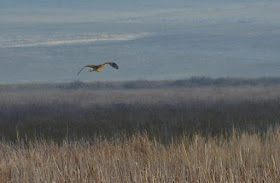 |
| Bill Williams National Wildlife Refuge |
Sometimes. Just sometimes this birding epic can be a little too much. On a gamble(or was it twitching?), we did something crazy. Four and half hours later, we found ourselves along the Colorado River and in the infamous Lake Havasu area. I had never been there before and it was the last area of Arizona that I needed to explore. The purpose of our exhausting mission? Loons. Lots and lots of loons. And a certain wintering Goldeneye.
People will say that we are crazy, but I am on a quest to add state birds to the Arizona list this month. We weren't just chasing a rare Yellow-billed Loon; we were chasing a large group of waterbirds that are normally rare for much of Arizona except for the Havasu area. They have been waiting for me to add them to my state list:) This is a very long trek for many Arizona birders. Therefore it's one of the least visited birding regions in the state. Well that is until the rarest loon in the world, the Yellow-billed Loon(Diver), decided to stop in Arizona. Their population is about 10000 worldwide and very little is known about this species of loon since they breed up in the icy regions of the far North. It is listed as an endangered bird due to habitat loss, oil spills and over fishing.
 |
| Hattie points us to our FOY American Robin! |
 |
| Ring-billed Gull |
 |
| Cold and windy, I make a fake smile. I'm freezing! |
We called out birds left and right. "Clark's Grebe! Wood Duck! Golden Eagles having sex..um...copulating!" But where was that Yellow-billed Loon?
 |
| Searching for that Yellow-billed Loon at Katherine Landing |
 | ||||
| Top from left to right: Yellow-billed Loon(wiki), Pacific Loon; Bottom left to right Red-throated Loon, Common Loon |
Many times a scope is necessary and even then it can be difficult. Such was the case with the Yellow-billed Loon. It hung out further away due to the human traffic. Here is the image I was able to capture(below).
 |
| When I visit Alaska and Canada, I hope to get better photos of this bird one day. The bill is large and upright making it stand out! |
 |
| You can note the size differences. In the photo, the YBLO hangs out with a Common Loon. It's more upright and larger making the COLO look like it's "slouching" in the water. |
I think my love for loons began as a child on the lakes of Minnesota where we'd vacation often. Their calls were the most haunting and beautiful sounds I have ever heard. My number one favorite movie of all time is "On Golden Pond". This movie heavily uses the Common Loon as a metaphor for life and relationships. And once a year, I revisit this incredible movie about this aging journey we all must make.
 |
| A rare Herring Gull-gulls are fun to ID! Really!! |
As we were getting ready to leave, we heard a loud blood curdling scream. I thought, oh oh. Magill has gone off the deep end! As I spun around, I was happy to see that she hadn't fallen into the cold waters but was horrified to see that her million dollar scope was sinking into the dark waters! She was able to recover the scope before it completely submerged into the depths of the unknown. It was like that first ding on your newly purchased car:(
 |
| Common Goldeneye |
 |
| Barrow's Goldeneye-drake |
 |
| Magill pointed out to me there differences between the female Common and Barrow's Goldeneyes. I think I got this one right. The bill on the female Barrow's Goldeneye is completely orange. |
After this trek, it was time to call it quits. There are no big years left. There just is. And that's a good place to be. It's time to educate younger birders and give back to a community who has given me so much. As for the loons? They're currently still hanging out:) Good birding!














































